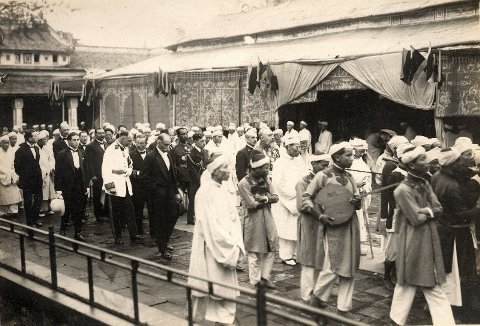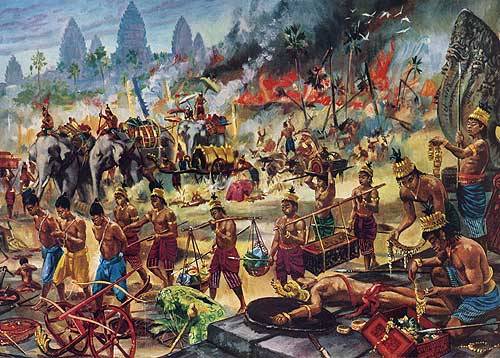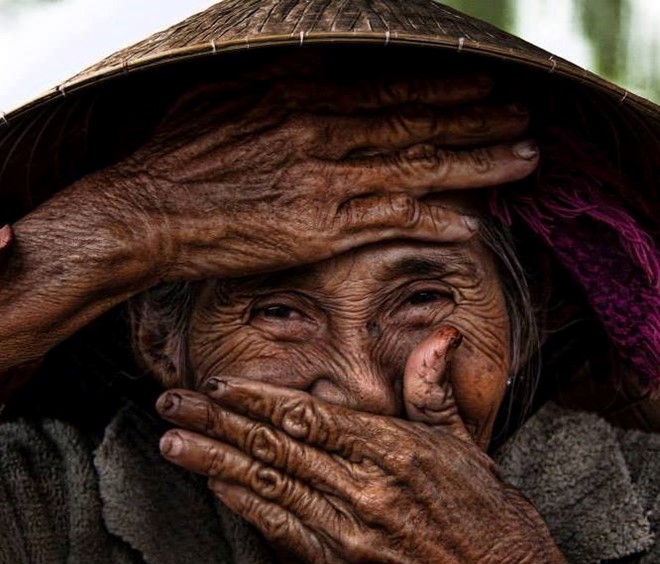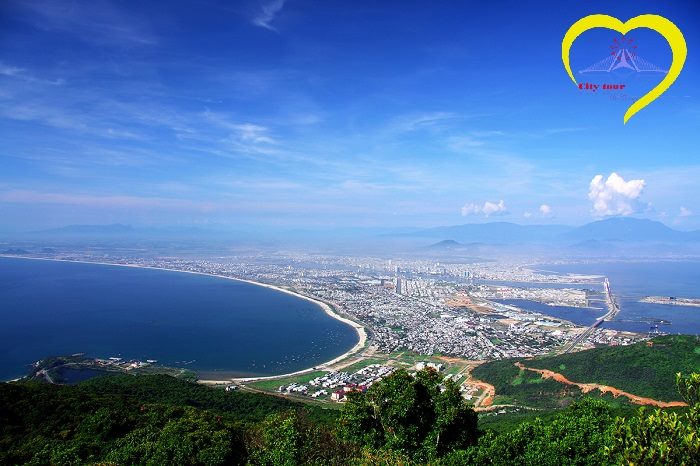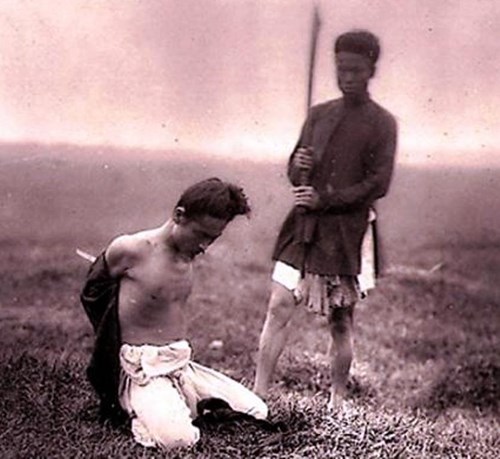Bài thuyết minh tiếng Anh về Huế
Mời các bạn hướng dẫn viên đọc và tham khảo bài thuyết minh tiếng anh về Huế của bạn Chau Luong.
OVERVIEW OF HUE
Author: Fb Chau Luong
 Thua Thien Hue is a province located in Central Viet Nam with 5010 KM2- in the total area and the number of population is 1.300.000 people. It borded Quang Tri Province to the north, Da Nang city to the South, and Laos to the west.
Thua Thien Hue is a province located in Central Viet Nam with 5010 KM2- in the total area and the number of population is 1.300.000 people. It borded Quang Tri Province to the north, Da Nang city to the South, and Laos to the west.Hue is a pronvincial city of Thua Thien Hue province. Hue feature the tropical monsoon climate. So, It divided into two distinct season, the dry season from March to August is rather hot and muggy with the high temperature about 40 degree.
The raining season from August to January is likely occur flood with the average temperature is around 19 degree. As you know, Hue was political and cultural centre of the Feudal state of Viet Nam, This explains why there are hundreds of historical and cultural remains located in area. As such, Complex of Hue monuments was listed as a world Cultural Heritage site in 1993.
Hue is also known as a Buddhist Centre of Viet Nam. There are more than 300 ancient Pagodas in Hue. Among those, Thien Mu Pagoda is a oldest one with more than 400 years old.
Kinh ethnic people account for 97% of provincial population mainly reside in Hue city and coastal districts. The Vietnamese is commonly used in almost fields in the region. Beside that, there are some ethnic groups in Thua Thien Hue Territory such as Bru Van Kieu, Ta Oi, Co Tu… etc.
The fact that Hue is well-known for having the best cuisine due to its Imperial legacy when all best chefs nationwide were summoned to create a large variety of dishes as the Emperors would eat dozens of different dishes at a single meal. Any Vietnamese people will agree Hue has tastiest product from fruit and vegetables to its sea food and this might be attributed to the city’s special climate and geography.
Hue is one of the few ancient capitals of the world that maintains today a cultural heritage of national and international importance. On making Hue capital of Viet Nam early in the 19th century, The Nguyen Dynasty had constructed here a complete urban complex in which the Perfume River took a vital role.
Fortifications and palace, where the Court held office and the Royal family lived, are built on the north bank of the river. Here exist 3 walled enclosures and hundreds of palaces and buildings.
1. Hue Citadel
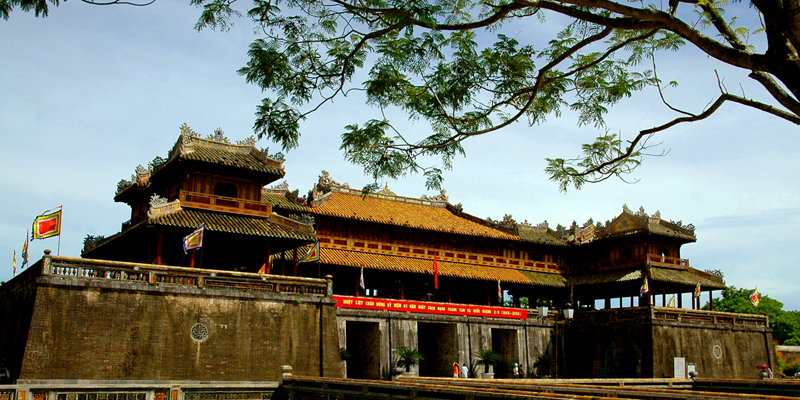
Hue is the only capital city of the Vietnamese monarchy that remains today. It was on principles of the Oriental Feng-Shui that walls and royal palaces of Hue was systematically planned an constructed.
This architectural complex faces southeast, taking the Ngu Binh Mount as a natural screen, Two islets in the Perfume River named Hen Islet and Da Vien Islet play the role of “Left Dragon” and “Right tiger” guarding the city.
-The first wall, known as the Citadel of Hue, , is built for the protection of al court activities. There are 10 entrances for access. It is believed that the first wall was built on Vauban design. Its’wall 6.6m in high, 21m in thick and over 10,000 m in circumference
-The second walls( imperial city) around 2400m in circumference, was the offices where manarch and high-ranking mandarins came for daily work. There are 4 antrances for access
-The third wall- Forbidden Purple City, about 1200m in circumfence , is private quarters of the Emperor and his family.
2. Great Enclosure
And within the Citadel, the Great Encosure, which consists of the Imperial City and the Forbidden Purple city, was constructed in 1804 and completed in 1833
a. Noon gate

Situated on the front of the Imperial City, the Noon gate was constructed in 1833 and reserverd for the Emperor. It was also used as a trinbune for Court regular and irregular festive occasions such as the Calendar Distribution Ceremony, Troops Parades,etc.
To fulfill these functions, Noon gate is divided into two parts, the foundation and the Five- Phoenix Pavilion. Both are U-shaped, symbolizing arms open for guests.
The foundation has five entrances. The middle is reserverd for the Emperor, four sideentrances for other participants in the royal procession including elephants and horses.
The five-Phoenix Pavilion has two stages. The top is formed by nine roofs. The middle roof, cover with yellow enameled tiles, shelters the monarch in ceremonious oaacasions. Eight side-roofs, covers with green enameled tiles, are seats for other members of the Court.
The Pavilion is supported by 100 columns. According to Oriental concepts, 100 is an infinite and countless number.
b. Palace of sumpreme harmony
Occupying the most important position in the Imperial City, The Palace of Supreme Harmony house the thrones seated by 13 emperors of the Nguyen Dynasty from Gia Long to Bao Dai. During Vietnam’s Monarchy, the Emperor was considered the greatest lord. The palace was thus once the country’s center.
It was built in 1805. Improvement and large-scale restoration work took place twice in 1833 and 1923
The palace, together with the Esplanade of Great Salutation, was the site for serious festive occasions such as the Conronation Ceremony, Emperor’s Birthday Anniversary and Grand meetings held bimonthly on the first and 15th days of the lunar month
On these occasions, the Emperor sat solemnly on the throne. Only his immediate relatives had access to the palace. Other mandarins lined on the Court according to their ranks and titles from the first to nineth grade. Civil mandarins on the left, military mandarins on the right.
The wooden canopy over the throne is elaborately carved and gilded. Eighty ironwood columns in the palace are lacquered and adorned with dragion and cloud designs symbolizing the rendezvous between the monarch and his subject. According to Chinese Classic, both the dragon and the number nine symbolize the monarch. This explains the presence of the nine-dragon motif in and outside the palace.
c. The Nguyen Temple(The Mieu)
The Mieu is an ancestral temple to Viet Nam’s emperors in the imperial city. It was constructed at the order of King Minh Mang in 1822-1823 for the pupose of ancestral worship of the past emperors of the Nguyen dynasty.
Under the French colonial, Ham Nghi, Thanh Thai, Duy Tan is 3 anti-French Kings, So they were not worshiped in The Mieu. 1959, at the request of the royal family and the people, a ceremony was held to admit to the temple mortuary of these 3 kings.
d. Hien Lam pavilion
Hien Lam pavilion can be considered as a memorial to those who had devoted their lives to the establishment and development of the Nguyen dynasty. Because of the holiness of the Pavilion, the Nguyen Emperors had ordered that no other construction built in the Citadel should be higher than this pavilion. That why, this is the highest bulding in the imperial city
e. Nine Urns
These are the nine greatest bronze urns in Viet Nam placed in the shade of Hien Lam pavilion, In front of the The Mieu temple. They were casted by the order of King Minh Mang symbolizing the sovereignty of the dynasty.
After their casting, the nine Dynasty, the nine dynasty Urn were placed in accordance with the disposition of the altars in The Mieu temple. Cao Urn stands in the center, alone in the first row. Because this urn symbolizes King Gia Long, the first emperor and the founder of the Nguyen dynasty.
On each urn are 17 traditional Vietnamese patterns like stars, rivers, mountains, seas and oceans, valuable forestry and sea products, etc. The 153 pattern on the 9 urns constitute a real encyclopedia on the country.
2.Tombs
Hue has sven tombs of seven Emperors of the Nguyen Dynasty, Planned and constructed in the hilly southwest of the Citadel. They have in common the following features.
– The construction was started almost during te Emperor’s reign
– Each tomb has dozen of splendid monuments in perfect harmony with poetical natural environment
– According to Oriental outlook, life is ephemeral and dealth means returning to the peaceful and eternal world. The royal tombs are therefore the living world of the deceased.
a.Tu Duc Tomb
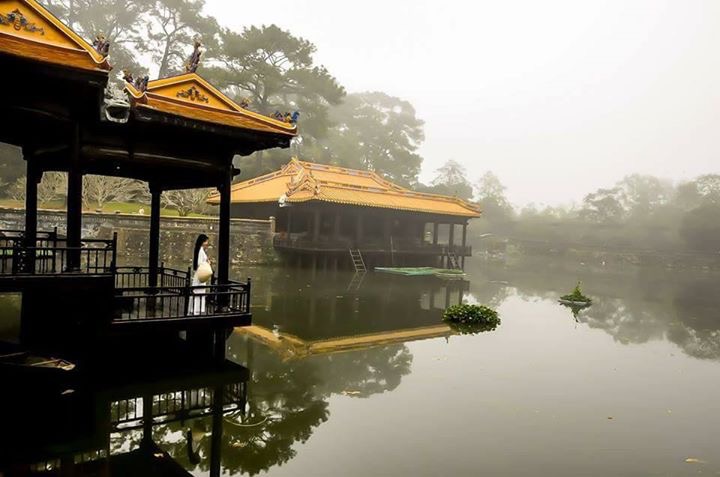
Born in 1829 and died in 1883, Tu Duc had reigned for over 35 years since 1848, longest among rulers of the Nguyen Dynasty. His tomb, with some 50 constructions surrounded by a 1500 m long wall, was built during 1864-1867.
Emperor Tu Duc was expert at philosophy, Oriental history and particularly literature( he left 4000 verse and 600 proses) yet failed to successfully rule the country. He was crowned King in the historical period of Viet Nam facing to the Western developing capitalism. Having no son to succeed aggravated the situation and made him world-weary. To seclude himself, he ordered the construction of his tomb as a fairy land with poetical features, making it a lifetime recreation ground and a world for his eternal life after death.
Architectural features of Tu Duc Tomb are imbued with poetry and freedom. Perfect harmony is ob tained of monuments and nature or nature improved on landscape gardening, a Vietnamese form of art. And, if unsysmetry is also a specific beauty of art, then Tu Duc Tomb enjoy it.
b. Khai Dinh Tombs
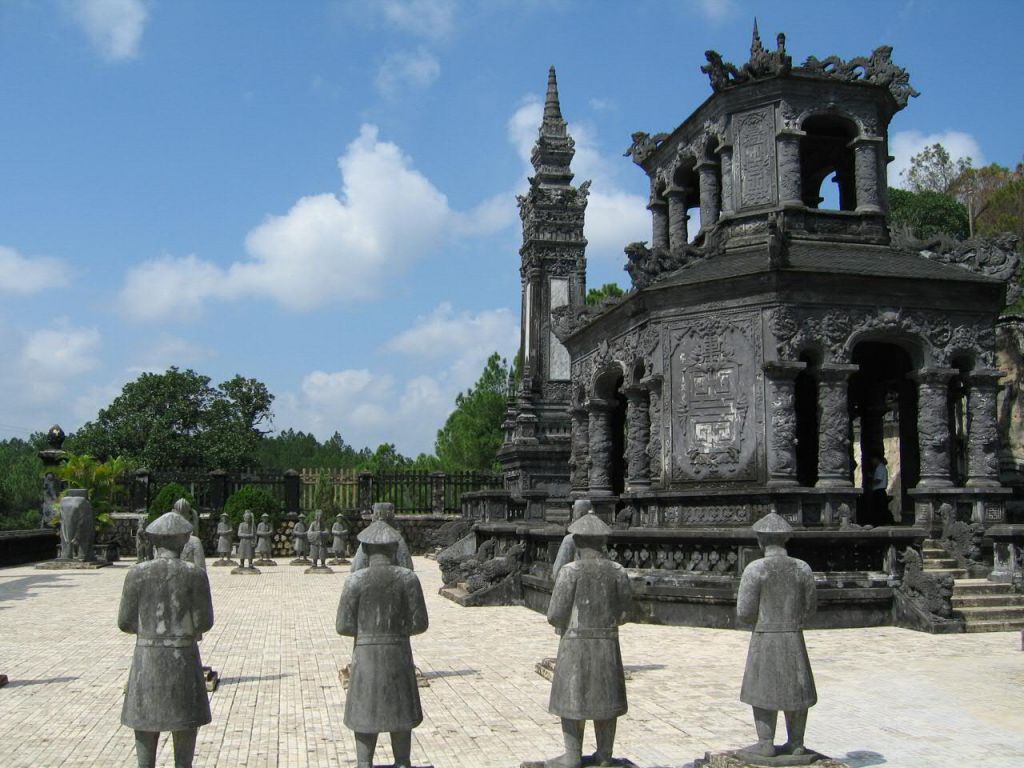
Emperor Khai Dinh ruled the country for 9 years from 1916 to 1925. His tomb, however, was built within 11 years, from 1920 to 1931, much longer than his reign.
Under Khai Dinh, Western culture vigorously infiltrated into Viet Nam. Khai Dinh himself made a tour to France in 1922. As a result, in his tomb, several elements of the western architecture have been intermingled with the nation’s traditional art, particularly the use of concrete in place of wood, ardoise slates for roofing, iron gates, lightning rods…
Mountains, hills, and rivulets round the tomb are exploited to fulfill the feng-shui requirements thus offer the tomb a majestic environment
Unique value of art of the tomb lies with the decoration skill obviously seen in the Thien Dinh Residence. It’s interior decoration features colourful mosaics made of millions of ceramic chips.
With diligence and expert hands, artisans of Khai Dinh times have created hundreds of mosaic bas relief, all elaborate and attractive with graphic designs and arabesques despite the hardness of the materials.
3.Thien Mu Pagoda
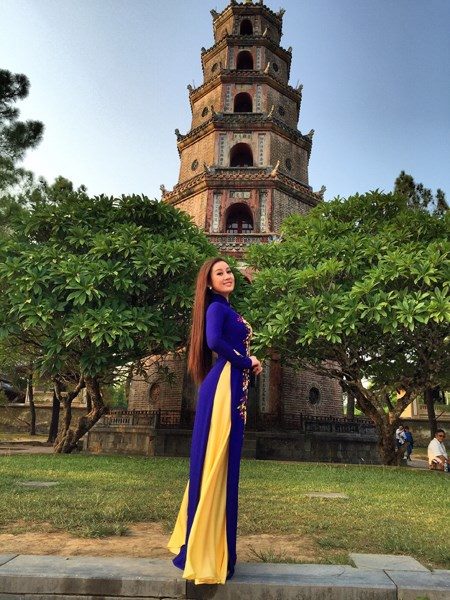
As you know, Hue is also known as a Buddhist Centre of Viet Nam. There are more than 300 ancient Pagodas in Hue. Among those, Thien Mu Pagoda is a oldest one with more than 400 years old.
The name takes its source from a legend. It was told that long ago, there appeared an old woman every night on the hill where the pagoda stands today. She told local people that a Lord would come and build a Buddhist pagoda for the country’s prosperity. Lord Nguyen Hoang, on hearing that, ordered the construction of a pagoda in 1601 and named it Pagoda of the heavenly lady.
Since then, it has been restored and developed several times. Two most important restorations took place during 1714-1715 in Lord Nguyen Phuc Chu’s reign and 1844-1846 under Emperor Thieu Tri.
The pagoda area can be divided into two sectors separated by the Triple Gate. The front sector comprises memorials such as:
Phuoc Duyen tower: The tower was built by King Thieu Tri in 1844 , and has become the unofficial symbol of Hue. Each of its seven stories is dedicated to a Buddha who appeared in human form. There is a Buddha statue placed on each story, in a small arched door
On the left of the tower is a pavilion sheltering an enormous bell. The bell, called Dai Hong Chung, was cast in 1710. It weighs 3285 kg and is 1.4 in circumference, IT is considered to be an outstanding achievement of 18th century bronze casting.
On the right of the tower is a pavilion containing a stela dating from 1715. It is set on the back of a massive marbe turtle, a symbol of longevity.
When you come to the entrance, you will first meet the two corpulent, one called Benevolence(Ong Thien) who gives encouragement to good people. The other, Mr Sterness, who punishes wrong does.
Dai Hung palace:
In the centre of the palace is the statue of Matreya Buddha. The future successor of Sakyamuni, represented as a fat man with a bare chest and a happly smile, showing that he is free from haman cares or worries.
In the nearest the roof is trinity representing the Past, the Present, and the Future, or the 3 bodies of Buddha.
Xem nhiều bài thuyết minh hơn tại đây: TÀI LIỆU THUYẾT MINH DU LỊCH

